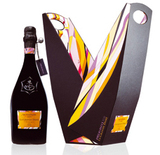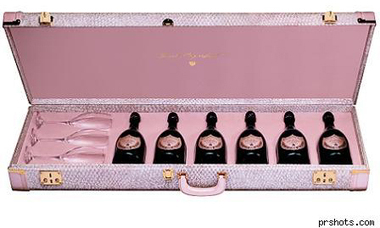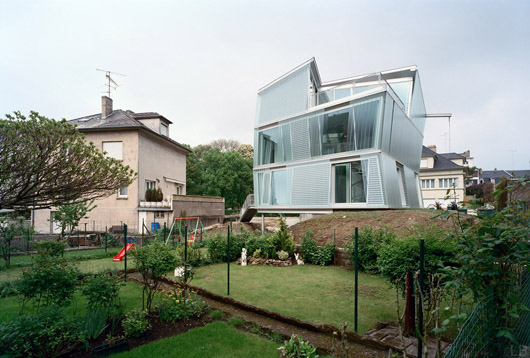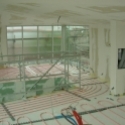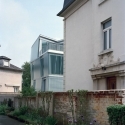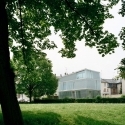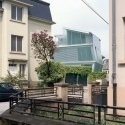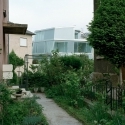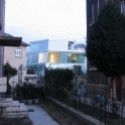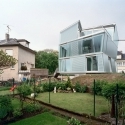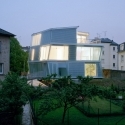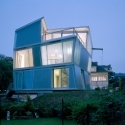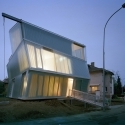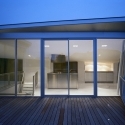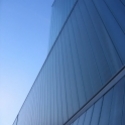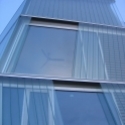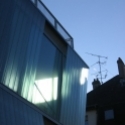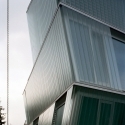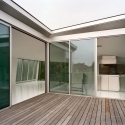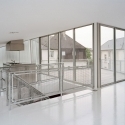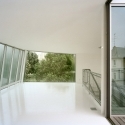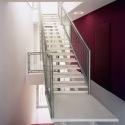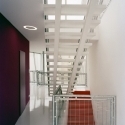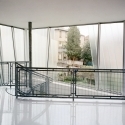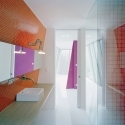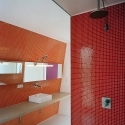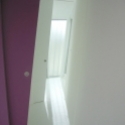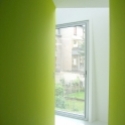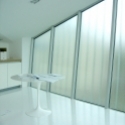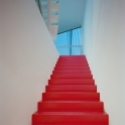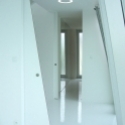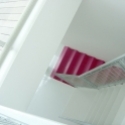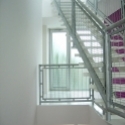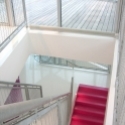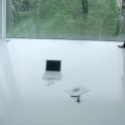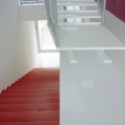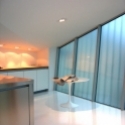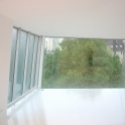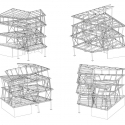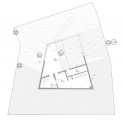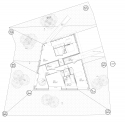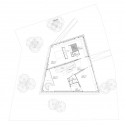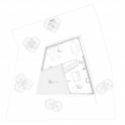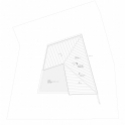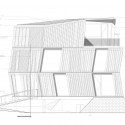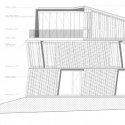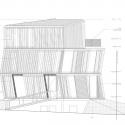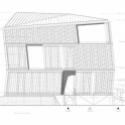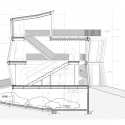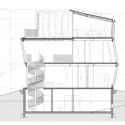
The Q Drum by P. J. and J. P. S. Hendrikse: A simple but yet so effective tool if you live miles away from a water source and you’d have to carry it all the way back. This container made of low-density polyethelene holds 75 litres and can be rolled easily. Manufactured in South Africa; shown at the
Design for the Other 90% exhibition at Cooper-Hewitt in New York. © 1993 P. J. Hendrikse
How about improving people’s lives and bringing an end to poverty? These Utopian aims aren’t impossible to obtain: The recent Design for the Other 90% exhibition at New York’s Cooper-Hewitt demonstrated that simple but effective gadgets for use in Third World countries and elswhere wouldn’t require so much effort to develop and produce. PingMag talked to curator Cynthia E. Smith. Written by Aroldo Cardoso Jr.
What was your initial motivation to gather and present all these objects?
I trained as an industrial designer, and for the past decade I’ve planned projects for institutions working in an architecture firm in New York City. Like so many others, I realised that our lives changed in September 2001… For two weeks, I roamed the streets looking for a way I could help in the aftermath - and found my design skills were nowhere needed. I began questioning: In what ways could I, as a designer, make a difference? While a number from my office volunteered with Imagine New York, I wanted to do more: A political activist my whole adult life, I decided to run for office to try to make an impact locally. I lost the race, but was accepted at Harvard University’s John F. Kennedy School of Government where I studied with people with a wide range of professions, from diplomacy, law, and human rights to economic development, housing, and architecture. We all endeavoured to help make the world a better place. After graduating, I felt I was armed to make that happen. Arriving back in New York, I was asked to curate an exhibition about affordable designs to help people out of poverty…

Now this is high tech with a fashionable touch: Sierra Portable Light Project by Portable Light Team, United States, 2006 - LEDs from pedestrian walk signals, water-resistant tactile switches from dishwashers, and rechargeable batteries from the cell-phone are woven into Mexican patterned textiles, such as easy to carry mats. Have an instant light source wherever you go! Photo by Stanford Richins.
 The mat by day: Sierra Portable Light Project by Portable Light Team, consisting of a woven aluminum textile, recyclable PET, flexible photovoltaics, semiconductors, and flexible wireways. Photo courtesy of KVA MATX.
The mat by day: Sierra Portable Light Project by Portable Light Team, consisting of a woven aluminum textile, recyclable PET, flexible photovoltaics, semiconductors, and flexible wireways. Photo courtesy of KVA MATX.How did you collaborate with producers and institutions?
I began looking for existing design solutions and put together an Advisory Board. As with all research, as one looks further you discover other items and stories along the way: from how a single engineer in Nigeria created a low cost way to bring vegetables to market with the Pot-in-Pot cooler, to a group in Switzerland who works with international aid organisations to stop the transmission of water-borne diseases with a personal mobile water purification tool; or a multi-sector collaboration to provide low cost laptops directly to governments in an effort to collapse the developing world’s literacy divide.
What would a socially responsible object be?
Innovations which help, rather than exploit, poorer economies, minimise environmental impact, increase social inclusion, improve healthcare at all levels, and advance the quality and accessibility of education. This is socially responsible design.

Solar-powered street lighting and WiFi in one. Really. StarSight by Kolam Partnership, Ltd. features light, battery, nex-g WiFi receiver and solar panel, developed in Malaysia and Indonesia, 2007. Currently used in the Ivory Coast, Cameroon and the Congo. Photo courtesy of Kolam Partnership, Ltd.
In terms of design, what can we learn from these solutions?
One of the contributors to Design for the Other 90% suggested that their work does not involve invention, because invention is starting with a broad problem, coming up with a very specific solution, and then trying to find a specific user for whom that solution is a good match. Design, on the other hand, is starting with a broad problem, finding a client who can narrow that down to a very specific problem, and then designing a specific solution to meet that need.
 Prevent waterborne diseases and unsafe drinking water with this handy purifier: LifeStraw by Torben Vestergaard Frandsen, China and Switzerland, 2005. Inside, it consists of halogen-based resin, anion exchange resin and patented activated carbon. © 2005 Vestergaard Frandsen
Prevent waterborne diseases and unsafe drinking water with this handy purifier: LifeStraw by Torben Vestergaard Frandsen, China and Switzerland, 2005. Inside, it consists of halogen-based resin, anion exchange resin and patented activated carbon. © 2005 Vestergaard FrandsenMore and more designers are helping people create micro enterprises with their products, a development in how these organisations are seeing how best to help people emerge from poverty. Potters for Peace’s Ron Rivera teaches NGOs how to manufacture the ceramic water filter in small batches. He would come back after a couple years only to find the project abandoned. Martin Fisher of the ’social enterprise’ KickStart from Kenya had similar experiences. Only when the microenterprise component was added did the different solutions become economically sustainable.
My hope is that this exhibition has opened eyes to the multitude of ways any one of us can take action to help end poverty. May the stories found in this exhibition inspire young designers, professionals working in the design field, educators, journalists, and each of us, to take a look.

In a developing country, even the battery for the hearing aid might be too expensive. Enter the SolarAid by Godisa Technologies, Botswana, 2003 as solar-powered hearing-aid battery recharger. Photo by Matt Flynn. © 2006 Smithsonian Institution
Can you talk a bit about how developed and underdeveloped regions can work together?
For example, for building on the appropriate technology movement which uses local materials, the designers work with the locals: One result, a cleaner charcoal made from sugarcane residue, is made and sold locally in Haiti. On the other hand, the Solar Aid hearing aid battery re-charger, designed and manufactured in Botswana, makes sense for every market: It uses renewable energy to recharge the battery, the most expensive part of the hearing aid. And the AquaStar Plus! UV water filter retails at close to US$100 for hikers and military personnel in developed countries - which allows the designer to provide a low cost version for large batch water filtration in developing regions. A product developed expressly for the needs of the developing world may very likely influence the next generation of products in more developed countries.
 900,000 people, mostly from landmine-affected countries, wear one: The Jaipur foot prosthesis by Master Ram Chandra Sharma and Dr P. K. Sethi, India, 1968, is made of various rubber compounds and a wooden heel.
900,000 people, mostly from landmine-affected countries, wear one: The Jaipur foot prosthesis by Master Ram Chandra Sharma and Dr P. K. Sethi, India, 1968, is made of various rubber compounds and a wooden heel.Indeed. How did developers come up with something like the Jaipur foot and below-knee prosthesis or the Bamboo Treadle Pump?
For that, designers were working across disciplines. An orthopedic surgeon teamed with a craftsperson to develop the Jaipur Foot. By creating local workshops, this organisation has produced and distributed close to one million of the prostheses since the late ’60s.
Also, the International Development Enterprise works in co-creation, interviewing rural small-plot farmers in Asia who are barely existing on less than $1 per day, to determine what they need to emerge out of poverty. For them, the Bamboo Treadle Pump is just one tool that can generate income, allowing even very poor farmers to access groundwater and lift surface water during the dry season. The irrigation water provides a basis for increased agricultural production and market participation. The treadles and support structure are made of bamboo or other inexpensive, locally available materials. The pump, which consists of two metal cylinders with pistons that are operated by a natural walking motion on two treadles, can be manufactured locally by metalworking shops. Almost two million have been sold in Bangladesh and elsewhere, generating US$1.4 billion in net income in Bangladesh alone.

Walking on water: the Bamboo Treadle Pump for poor farmers to access groundwater during the dry season. Designed by Gunnar Barnes and International Development Enterprises Nepal, Nepal and Bangladesh, 2006. © 2003 International Development Enterprises
Might something like the Bamboo Treadle Pump have been used before, but people somehow forgot traditional techniques?
These designers innovate by combining and sampling not only from current technology, but also from previously abandoned and even emerging technologies.
 Big problem, simple solution: How to preserve tomotaoes in the desert heat? The Pot-in-Pot Cooler has a sand-water combination between a smaller and a bigger pot, thus cooling the vegetables inside. Design by Mohammed Bah Abba, Nigeria, 1995. © 2000 Tomas Bertelsen
Big problem, simple solution: How to preserve tomotaoes in the desert heat? The Pot-in-Pot Cooler has a sand-water combination between a smaller and a bigger pot, thus cooling the vegetables inside. Design by Mohammed Bah Abba, Nigeria, 1995. © 2000 Tomas Bertelsen…to be also used for crisis situations, such as for the victims of Katrina in New Orleans…
There were several objects that were developed in response to natural disasters. One New Orleans solution, the Katrina Furniture Project, used debris from the storm, but also addressed the limited social and economic capacity that existed prior to the hurricane. The furniture is built in local community workshops. This example illustrates how this area of design addresses not only function, but also has a very strong social and economic component.
Speaking of economic matters: It’s expensive to be poor, says one member in the other90% website trailer. Could you explain what he meant by that?
You are referring to Paul Freedman, who found that often the poor end up spending more of their limited resources to repair a poorly made bicycle - their main mode of transportation and source of income. Even purchased new, they must pay a repair person an additional 20 percent of the purchase cost just to get it in working order. Any modifications and maintenance costs are also high. He states that’s why we got involved in this challenge, because the riders are spending so much to maintain these bikes. I mean it’s truly unfair. It’s one of these examples where it’s expensive to be poor. Thus, the Worldbike exists as a challenge to the bicycle industry of how to design bikes for customers in developing countries for manufacture in the world’s bicycling centres of Taiwan, China and India.
 Easy to assemble furniture for hurricane victims: Made of recycled cypress, e-flute material and paper stock, the YouOrleans boxes by the Art Center College of Design’s Graphic Design department. Photo courtesy of the Art Center of College and Design.
Easy to assemble furniture for hurricane victims: Made of recycled cypress, e-flute material and paper stock, the YouOrleans boxes by the Art Center College of Design’s Graphic Design department. Photo courtesy of the Art Center of College and Design.And lastly, in terms of distribution, how does a tool like that get to the people?
There is a whole range of ways: From fully subsidised water filters like the LifeStraw, which are distributed via international aid organisations to populations hit by natural disaster or living in refugee camps. While the Kenya Ceramic Jiko stove is selling locally at a very low cost: This successful product began with multiple input from various non-profits and NGOs until it hit a tipping point where over 50% of the households in Kenya now use this efficient cooking stove. Many projects require this front-end investment until they become locally accepted and economically viable.
So, projects like these need designers that love to work interdisciplinary. Come on, folks! Thanks Cynthia.
